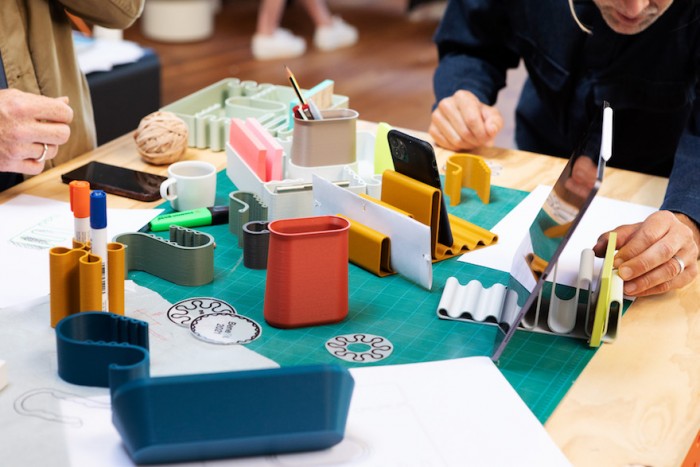London-based designer and Design Indaba alumnus Luke Pearson, who makes up one half of Pearson Lloyd, has earned a following for his mindful, elegant approach to design. His recent project bFRIENDS exemplifies the company’s ethos by using design to respond to environmental challenges.
Launched in November 2021, bFRIENDS is a collection of desirable desktop accessories for home and office use. The products, which are available in ten standard colours, have been manufactured with a 3D printer and appear to have been shaped by a continuous, instinctive line. As a result, these objects merge a warmth and tactility with an element of sophisticated practicality.
The collaboration that led to bFRIENDS came about after Pearson Lloyd moved into their new studio during the Covid-19 lockdown. “That winter, some neighbours moved into a broken-down warehouse opposite and were feverishly renovating and setting up a workshop,” Pearson reveals. “This was the eco start-up Batch.Works. We went over to meet them and found they were 3D printing – they had an interesting process of automation where the printers would knock off the finished article then start printing again, with cameras set up so they could monitor the process remotely.”
The bFRIENDS idea was hatched then and there, with Pearson drawing in Austria-based officer furniture company Bene, which has an eco-conscious business model. “We knew lockdown had reduced everyone’s willingness and capacity to develop new products, and we needed to think differently,” Pearson says. “We thought desk accessories were a good scale. Bene is a very entrepreneurial client and we brought everyone together.”
For Pearson, the prospect of 3D printing was a very exciting one. He states how one of its most alluring features is the fact that there is no tooling involved.
“When you injection mould plastic, the steel tools and machines are vast, so you have to use a huge amount of material simply to make the very first item,” Pearson says. “If you make an error or the design is not very popular, that’s all wasted, and you also have to print thousands for commercial viability. 3D printing is viable with very small numbers – we can continually adjust the design and print on demand, so there is no waste.”
The accessories are made from PLA, a bioplastic derived from cornstarch and used for food packaging. The PLA is re-routed from local landfills by Batch.Works. The closed-loop system of production helps to reduce waste and consume less material and energy, according to Pearson. “A durable, long-life product is thrown away or replaced less often, which means less shipping and mining,” he points out.
How does one design such a recyclable product?
“Be efficient with the materials you use and try to ensure separation can be facilitated for repair or for dismantling to recycle at the end of life,” Pearson advises. “Make it strong so it doesn’t break. Don’t make it with too much material that’s over-designed. Try to avoid designing objects that are fashionable and transient. They will be discarded for emotional reasons, not functional ones.”
Pearson Lloyd carefully considered the choice of materials for the product.
“If a material can be recycled, it may be better than something that can’t, but seemingly comes from a better source,” he says. “Consider how many materials you combine as that means they are being sent from multiple locations. In general, most mechanised processes use fossil fuels, so consider how to reduce every process in order to arrive at the end result.”
Pearson says shipping and transport are often the most damaging aspect of product production and delivery. “Make local if that’s better and ensure products are as light as possible and stack well for transport,” he advises.
The launch of the product marks a small but significant step forward in the global drive to shift manufacturing from linear production methods to sustainable, closed-loop systems. “The launch of bFRIENDS is exciting new territory for us, and makes Bene one of the very first furniture brands to offer a 3D-printed accessory line,” says Michael Fried, the managing director of sales, marketing and innovation at Bene. “Pearson Lloyd’s design brilliantly demonstrates their capacity to balance form and function, and responds honestly and elegantly to both the material and the process of 3D printing. The circular manufacturing model being pioneered by companies such as Batch.Works offers real hope for the sustainable future of design and production – and the collection is proof that it works. bFRIENDS is only the beginning.”
Read more:
Luke Pearson on innovation, big or small.
Dirk van der Kooij on 3D printing and recycling.
Credits: Supplied











